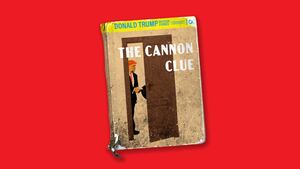U.S. District Judge Aileen Cannon, whose pro-Trump bias and head-turning errors have raised questions about whether she should be overseeing former President Donald Trump’s criminal trial in Florida, made what appears to be another surprising mistake last year.
Now, a defense lawyer is seizing on her misstep to try freeing his client from prison—even though he was caught on tape violently throwing a courtroom chair at a prosecutor and threatening to kill him.
The blunder was simple and entirely avoidable. The federal judge told jurors they could find the man, Christopher Wilkins, “guilty or not guilty.” But then she handed jurors a verdict form that didn’t even have those options.
“How far does somebody have to go to school to say that a verdict form is supposed to say guilty and not guilty?” asked defense lawyer Jeffrey Garland. “That would be one of the more egregious versions of jury instruction error… it’s such a rare error.”
Garland formally filed an appeal on Thursday and hopes to overturn a case that’s as black-and-white as they come—on a technicality.
“This is the judge’s deal. This is nobody else’s deal. I’m gonna tell ya, I’ve done a lot of appeals, and I’ve got a pretty good winning record. This is a great issue,” he said. “For a guy who’s on tape throwing a chair in court, it’s pretty ‘not good’ behavior. It would have been simple. You have a trial, properly instruct a jury, give them a form, and the jury’s gonna do what the jury’s gonna do.”
Cannon’s short and controversial history on the bench is under a microscope, given that she is presiding over such an historic criminal trial: that of a former president facing prison time for mishandling classified records at Mar-a-Lago and lying to the feds in a coverup. Trump himself appointed her in his final months in office, yet she has not recused herself from the case.
Cannon first came to people’s attention last year, when Trump’s lawyers were chastened by a judge who accused them of trying to game the judicial assignment system in a brazen attempt to have her oversee a conspiracy-laden lawsuit against political rival Hillary Clinton.
But she gained notoriety when Trump sued to block the feds from investigating Mar-a-Lago and she was oddly assigned the case, despite being in a distant corner of the district far from Trump’s mansion. Cannon immediately began to issue bizarre orders that froze the investigation—until appellate judges told her to back off. A court screwup even exposed how she was bending over backwards to appease the man who appointed her.
But now she’s come under fire over her inexperience.
Last month, The New York Times discovered that Cannon has only handled four trials, collectively accounting for just 14 days in court—less than three weeks of experience before handling a potential turning point for American democracy. Last week, Reuters exposed how Cannon kept family members of an accused viewer of child sex abuse locked out of her courtroom during some of his trial in June, violating his Sixth Amendment rights to have a public trial—and somehow forgot to swear in the prospective jury pool, the most basic of mandatory procedures.
Now, The Daily Beast can confirm that Cannon made yet another round of gaffes during a two-day trial.
First the backstory: Wilkins, who had already served time behind bars, ran into problems while at a halfway house and got caught with guns. When a Fort Lauderdale jury eventually read his guilty verdict on the evening of Nov. 7, 2019, an enraged Wilkins grabbed his chair in the courtroom and flung it at the prosecutor across the room while yelling, “I’ll kill you when I catch you, boy!” A video camera and court reporter’s audio device recorded it all.
Fast-forward three years, and Wilkins found himself in court again, this time before Judge Cannon, for attacking the federal prosecutor.
The Daily Beast reviewed 500 pages of trial transcripts that show what went on during the two-day ordeal in January 2022. Prosecutors and Wilkins’ defense lawyer couldn’t agree on jury instructions—minor stuff, like whether to use “deadly or dangerous” rather than “deadly and dangerous.” But the judge surprised the lawyers when she came back with her own verdict form, which looked nothing like the kind given to jurors at a typical criminal trial.
Cannon’s draft asked: “Did the Government prove beyond a reasonable doubt that Defendant Christopher Tavorris Wilkins committed forcible assault against a federal officer with a deadly or dangerous weapon?” The listed options were either “yes” or “no.”
At the time in court, Wilkins’ lawyer objected, twice pointing out to the judge that “guilty/not guilty” is “the traditional nomenclature.”
Judge Cannon wouldn’t reconsider.
“So, I’m going to finalize the ultimate language, but I don’t see at this point anything legally incorrect about the manner in which the verdict form is drafted as to Count 1 or Count 2, although, I note your arguments in opposition, Mr. Garland,” she said, according to the transcript.
This isn’t a minor issue. In deciding to hand jurors that questionnaire, Cannon took a novel approach to something that’s fairly basic in criminal trials. For example, jurors in Washington were asked whether the right-wing MAGA fanatic Elmer Stewart Rhodes was guilty or not of seditious conspiracy for planning an armed revolt on Jan. 6, 2021. New York jurors checked off “guilty” when deciding that the lawyer Michael Avenatti had committed wire fraud and identity theft for stealing nearly $300,000 from his porn-star client, Stormy Daniels. Jeffrey Epstein’s right-hand woman, Ghislaine Maxwell, was sent to the clink after jurors selected “guilty” on a form that asked whether the socialite engaged in child sex-trafficking.
Yet, in her South Florida courtroom, Cannon chose to draft yes/no questions that read more like the kind of verdict form given to jurors when they consider specific elements of a crime.
“That’s her verdict form. There’s no ‘guilty’ and ‘not guilty.’ The traditional format is ‘guilty’ and ‘not guilty,’ as it was on the proposed form the government and I had created. We agreed on that. And she comes up with this. This is her creation. This is her baby. It’s kind of funny. It’s ridiculous,” Garland told The Daily Beast.
“Nowhere on this form is there any opportunity to find him ‘not guilty.’ What kind of trial is this? The judge said ‘guilty’ on a make-believe trial,” he said, quoting from a Reba McEntire country song.
Garland filed an appeal on Thursday to the 11th Circuit in Atlanta—the same judges who reversed Cannon’s decisions on Trump earlier this year.
Phone calls to Cannon’s court staff went unanswered on Thursday.
The Daily Beast reviewed this with several legal scholars, who universally noted that Cannon’s move here strikes them as odd.
“I’ve never seen anything like it. I am a law professor, and I found it cumbersome to read and follow,” said Elizabeth Taxel, who spent a decade as a DeKalb County public defender and now teaches at the University of Georgia. “It’s unclear to me why the court didn’t, out of an abundance of caution, include ‘guilty or not guilty.’”
Others noted that these kinds of “special verdicts,” as they’re called, are rarely used—and only in the most strange or complex cases. Columbia Law School Professor Daniel Richman noted how a Virginia jury in 2009 faced detailed questions when deciding to convict the disgraced congressman William Jennings Jefferson (D-LA). But even in that complicated case, in which jurors were asked whether the government managed to prove any of 12 different racketeering acts, they were still asked to decide if he was guilty or not.
“The primary role they play is guilt/non-guilt, and that ought to be specified. Perhaps for a matter of local practice in the Southern District of Florida, that’s not done here,” Richman said.
But if Cannon’s verdict is perceived to be unfair, he said, that’s on her.
“To the extent that she introduced a formulation that arguably prejudiced the defendant, that’s a kind of error,” Richman added.
Jenny Carroll, a professor at the University of Alabama’s law school, stressed that these types of jury forms are exceedingly rare. She pointed to at least one instance where it was used successfully: in convicting Zacarias Moussaoui, the French member of al-Qaeda known as the 20th hijacker of the September 11, 2001, terror attacks on the United States. But jurors were asked those questions during the second phase of a trial, and the questions related to aggravating factors to the underlying crime.
“It’s very unusual—super-unusual—which is why you’ve probably never seen one,” Carroll said. “Even within these specific verdict forms, you nonetheless end up with an ultimate question where the jury has to check ‘guilty’ or ‘not guilty.’ And that’s what you’re missing on this form.”
All three law professors agreed that an appeal could venture into relatively unexplored territory and open up a spicy debate: What exactly is the role of the jury?
"What strikes me is, they have been asked to consider these bifurcated factual questions and to answer them ‘yes’ or ‘no’ without ever getting to the ultimate question: Should we conclude this person is culpable and should be punished as a criminal? Which is really what you’re asking when you say, guilty or not guilty,” Carroll said.
She summarized what she would say on a theoretical appeal.
“You, judge, took away some of the job of the jury. And you did it without any authority to do so. You’re an Article III judge, which has a lot of power, but you don’t have the authority to do this,” Carroll said. “The ultimate fact finder is the jury, and you took away the last question they're entitled to answer.”
Of course, this is based on a technicality. Jurors clearly concluded that Wilkins threatened to murder a law enforcement officer and committed forcible assault with a deadly or dangerous weapon. And as Wilkins’ own lawyer admits, the evidence in the case was pretty stark: video footage and recorded prison calls where he boasted about attacking his prosecutor. In that sense, Cannon’s error may seem trivial. But her refusal to use the proper legal terminology has introduced an avenue for appeal—while once again demonstrating that Cannon is comfortable playing fast and loose with hundreds of years of legal traditions.
As the judge overseeing the Department of Justice special counsel’s criminal case against Trump in Florida, every word she utters in court and each decision she makes will be closely scrutinized by the entire American legal society.
Already, law professors have criticized how she seemed to have gone out of her way to reveal the existence of an unknown grand jury investigation—which are typically kept secret—that’s outside South Florida and apparently still probing Trump’s actions. She’s also taken heat for scheduling his classified documents trial for May 2024, leaving the former president free to travel across the country in his bid to secure the Republican nomination during the bulk of the primary election season.









